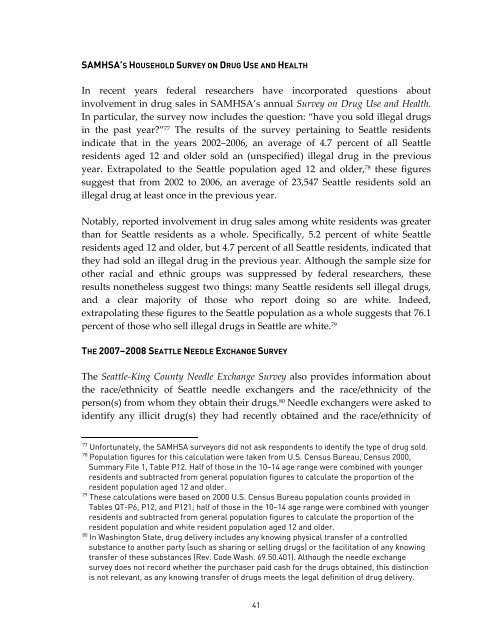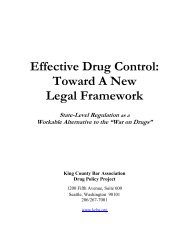RACE AND THE ENFORCEMENT OF DRUG DELIVERY LAWS IN ...
RACE AND THE ENFORCEMENT OF DRUG DELIVERY LAWS IN ...
RACE AND THE ENFORCEMENT OF DRUG DELIVERY LAWS IN ...
You also want an ePaper? Increase the reach of your titles
YUMPU automatically turns print PDFs into web optimized ePapers that Google loves.
SAMHSA’S HOUSEHOLD SURVEY ON <strong>DRUG</strong> USE <strong>AND</strong> HEALTH<br />
In recent years federal researchers have incorporated questions about<br />
involvement in drug sales in SAMHSA’s annual Survey on Drug Use and Health.<br />
In particular, the survey now includes the question: “have you sold illegal drugs<br />
in the past year?” 77 The results of the survey pertaining to Seattle residents<br />
indicate that in the years 2002–2006, an average of 4.7 percent of all Seattle<br />
residents aged 12 and older sold an (unspecified) illegal drug in the previous<br />
year. Extrapolated to the Seattle population aged 12 and older, 78 these figures<br />
suggest that from 2002 to 2006, an average of 23,547 Seattle residents sold an<br />
illegal drug at least once in the previous year.<br />
Notably, reported involvement in drug sales among white residents was greater<br />
than for Seattle residents as a whole. Specifically, 5.2 percent of white Seattle<br />
residents aged 12 and older, but 4.7 percent of all Seattle residents, indicated that<br />
they had sold an illegal drug in the previous year. Although the sample size for<br />
other racial and ethnic groups was suppressed by federal researchers, these<br />
results nonetheless suggest two things: many Seattle residents sell illegal drugs,<br />
and a clear majority of those who report doing so are white. Indeed,<br />
extrapolating these figures to the Seattle population as a whole suggests that 76.1<br />
percent of those who sell illegal drugs in Seattle are white. 79<br />
<strong>THE</strong> 2007–2008 SEATTLE NEEDLE EXCHANGE SURVEY<br />
The Seattle-King County Needle Exchange Survey also provides information about<br />
the race/ethnicity of Seattle needle exchangers and the race/ethnicity of the<br />
person(s) from whom they obtain their drugs. 80 Needle exchangers were asked to<br />
identify any illicit drug(s) they had recently obtained and the race/ethnicity of<br />
77 Unfortunately, the SAMHSA surveyors did not ask respondents to identify the type of drug sold.<br />
78 Population figures for this calculation were taken from U.S. Census Bureau, Census 2000,<br />
Summary File 1, Table P12. Half of those in the 10–14 age range were combined with younger<br />
residents and subtracted from general population figures to calculate the proportion of the<br />
resident population aged 12 and older.<br />
79<br />
These calculations were based on 2000 U.S. Census Bureau population counts provided in<br />
Tables QT-P6, P12, and P121; half of those in the 10–14 age range were combined with younger<br />
residents and subtracted from general population figures to calculate the proportion of the<br />
resident population and white resident population aged 12 and older.<br />
80<br />
In Washington State, drug delivery includes any knowing physical transfer of a controlled<br />
substance to another party (such as sharing or selling drugs) or the facilitation of any knowing<br />
transfer of these substances (Rev. Code Wash. 69.50.401). Although the needle exchange<br />
survey does not record whether the purchaser paid cash for the drugs obtained, this distinction<br />
is not relevant, as any knowing transfer of drugs meets the legal definition of drug delivery.<br />
41

















